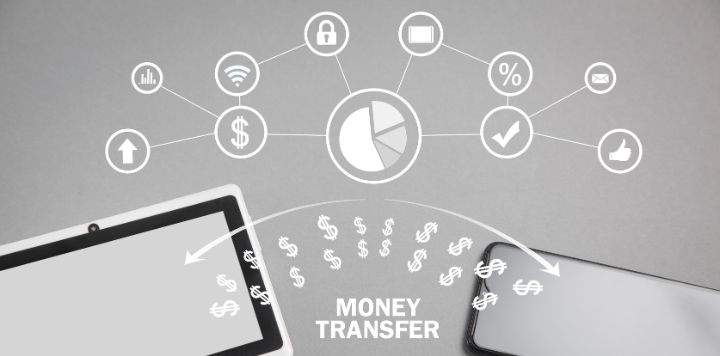In recent years, the number of Indian students seeking higher education abroad has surged. The United States, Canada, Germany, the United Kingdom, and Australia are the most chosen destinations for Indian students. By 2025, it is projected that two million Indian students will be enrolled in foreign universities, and are expected to spend up to $70 billion. It is indeed a significant accomplishment to secure a spot in a foreign institution, however, paying tuition fees shouldn’t be a roadblock.
Different Ways to Pay Fees for Overseas Education in 2025
We have compiled a list of the most widely known payment methods to pay the tuition fee in a foreign university. It is crucial for students to carefully assess and research these options, and make informed decisions about how to pay fees for their overseas education.
1. Wire Transfers via Banks
Banks are long-established and regulated, providing a sense of security and trust when it comes to international money transfers. However, banks charge higher fees (often up to 2000 Rs) for wire transfers, which can include service fees and high markups on exchange rates.
Transfers can take 3-4 business days, if intermediary banks are involved. Transfer options and tracking might be less flexible compared to modern digital money transfer platforms.
2. Wire Transfers via Money Transfer Platforms
Money transfer platforms often have lower fees compared to banks and offer more competitive exchange rates. Transfers can be completed within 12 to 48 hours, depending on the platform.
Many platforms also offer a user-friendly experience with mobile apps, making it easy to initiate and track transfers. Transfers can be done anytime, from anywhere, without the need to visit a bank branch.
BookMyForex offers a seamless and cost-effective international money transfer service, making it easy for students and families to send money abroad. With the lowest exchange rates and zero transfer charges, BookMyForex ensures that your funds reach their destination securely and affordably through our reputed partner banks.
3. Demand Draft:
While this method remains secure for paying tuition fees, it is less commonly used due to its lack of convenience. To use this method, visit your bank and request a demand draft in favor of the university. The bank will issue the demand draft after deducting the necessary funds from your account.
You will then need to send the demand draft via mail to your university. Once they receive it and deposit it in their bank, the funds will be credited to their account. While this method may take 10-15 days, it can typically be more cost-effective than other options.
4. Forex Cards
A Forex card is a globally accepted prepaid card that can be used to make tuition fee payments. Pick a forex card that offers zero cash disbursal fees instead of those that charge 2% or more for such transactions.
For example, if you need to pay ₹1,00,000 in tuition fees using a forex card that has a 2% cash disbursal fee, you’d be paying an additional ₹2,000 just in fees. Hence, using a card with zero cash disbursal fee can result in significant savings for students, especially when paying large sums of money for tuition fees.
5. Credit Cards
Some universities allow students to pay their tuition fees using credit cards. However, this can be a very expensive option as the interest on credit cards is quite high. Before opting for this method, carefully consider the additional charges you might incur, especially for significant amounts like tuition fees.
Let’s say you need to pay ₹1,00,000 in tuition fees using a credit card. Suppose your credit card has an annual percentage rate (APR) of 18%. So, if you pay off the balance in 6 months, you might end up paying an additional ₹9,340 in interest, making the total amount paid ₹1,09,340.
6. International Money Order
An International money order is an order from the Post Office of India to send an amount of money abroad to the individual in whose name the money order is sent via the Post Office’s department.
Money orders are rarely used by people these days to pay tuition fees for a foreign university. One of the biggest cons is that you can only transfer a certain sum in a single transaction, so you might end up having made a lot of money orders.
| Options | Pros | Cons |
|---|---|---|
| Wire Transfer | Fastest Mode of Transfer, Convenient & Secure Process | Although a little expensive if done via banks, fintech platforms have made it quite affordable |
| Demand Draft | Safe & Economical, Cheaper than other options | Lack of Convenience, Time taking; takes 10-15 days |
| Forex Cards | Zero rate fluctuations, best exchange rates, lower transaction fees, zero cash disbursal fee for fee payments | Expensive if the card comes with high cash disbursal fees |
| Credit Cards | Global Acceptance, Convenient to use if you already have one | Open to rate fluctuations, Hefty interest charges on credit card |
| Money Order | Old-school method, safe & affordable option | There is a cap on how much can be transferred in one transaction, You may have to make multiple money orders |
Why is BookMyForex the Best Choice for Sending Money for Overseas Education?
When it comes to sending money abroad, it’s important to choose a service provider that is reliable, convenient, and cost-effective. With so many options available, it can be overwhelming to find the best solution. BookMyForex stands out from the competition and proves to be the ultimate choice for sending money abroad for overseas education.
1. Live Rates: Unlike fixed exchange rates used by banks and other money exchangers, we provide live rates, saving you up to 3% on your transactions.
2. 24*7 Fully Online Booking Process: Visiting the bank or branch is a thing of the past now. With our fully online remittance facility, the entire process can be completed online.
3. Zero Transfer Charges: When you choose BookMyForex, you can take advantage of zero transfer fees. By using the promo code “ZEROBANKFEE,” you can conveniently send money abroad without any extra charges or surprises.
4. Fast Processing: You can efficiently send tuition fees abroad to over 150 countries, with funds securely reaching their destination in just 12-48 hours.
5. Trusted Banking Partners: BookMyForex has partnered with trusted banks in India, such as Yes Bank, RBL Bank, and other reliable institutions to offer safe and reliable international money transfer services.
6. Transparency and Cost Efficiency: We are committed to transparency in forex transactions. You won’t encounter hidden costs or unfavorable exchange rates.
7. Exclusive Student Discounts: BookMyForex provides exclusive offers and cashback to students for their international tuition fee payments. Rest assured, you can rely on us to get the most favorable deals.
8. Rate Lock Facility: By paying a small refundable fee of 2% of the total amount, you can lock in the desired rate for up to 3 days, ensuring you get the best value for money.
9. Rate Alert Feature: Set alerts for your preferred rates for tuition fee payments. No need to constantly monitor rates; we’ll notify you when your desired rate is available.
10. Quality Customer Support: Our support team is fully dedicated to addressing any questions, issues, or challenges that customers may encounter when sending tuition fees abroad.
How to Pay Your Tuition Fee Abroad With BookMyForex Money Transfer Service?
By following the below-mentioned steps, you can easily book your order online with BookMyForex and pay your tuition fee for overseas education:
Step 1: Order Details: Choose your city, and country to which you are sending money, & enter the amount.
Step 2: Customer Details: Verify the remitter’s details via Aadhar card and PAN card
Step 3: Eligibility Check: Specify the purpose of your remittance and upload applicable documents.
Step 4: Order Processing: Enter beneficiary details such as name, address, bank name, routing number, bank address, account number, & Swift code
Step 5: Review Order: Check your order details & then make payment via Net Banking, NEFT/RTGS or UPI



























